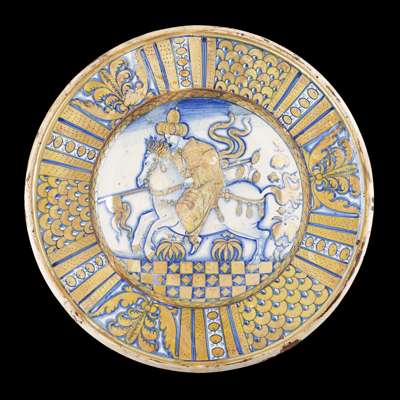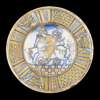
Lot 40

ITALIAN MAIOLICA "TURKISH HORSEMAN" LUSTRE DISH
DERUTA, CIRCA 1520


Auction: 22 October 2013 at 18:00 BST
Description
having a sloping rim and a flanged edge, the foot rim pierced with two holes for suspension, the front tin-glazed and painted in dark blue, and yellow lustre, in the centre a mounted bearded turbaned horseman, galloping to the left, barefoot, wearing a long flowing outer garment with an extended collar and carrying a standard with ribbons fluttering behind, the border in sections of scale pattern, palmettes and radial stems with buds
Dimensions
42cm diam, 8.4cm high
Footnote
Provenance:
In the collection of the family of the present owners since the late 19th / early 20th century. Entries in the family archives suggest that maiolica was acquired between 1894 and 1916 from three different sources: from G. Donaldson in 1894 (with two items bought from the Spitzer Collection) in 1896 and in 1897; from H.A .Peto in 1899 and from S.M. Crossley in 1908 and in November 1916. The majority of the entries with a few exceptions are however unidentifiable
Note:
Wilson & Sani, Poole and Watson and others have noted that Deruta lustred dishes decorated with Turkish horsemen are less common than polychrome versions. (T. Wilson and E.P.Sani, Le maioliche rinascimentali nelle collezioni della Fondazione Cassa di Risparmio di Perugia, cat.17, p.56, vol 1,Perugia, 2006; J. Poole, Italian Maiolica and incised slipware in the Fitzwilliam Museum, cat. 273, p.200 and colour plate 19, Cambridge,1995; W. Watson, Italian Renaissance Ceramics. The Howard I. and Janet H. Stein Collection and the Philadelphia Museum of Art, cat.69, p.204, Philadelphia, 2000). The border is found on Deruta lustred maiolica from 1510, see D. Thornton and T. Wilson, Italian Renaissance Ceramics: A catalogue of the British Museum collection, cat. 280, note 15, p.472, London , 2009. A polychrome version of this Turkish horseman is attributed to the Mancini worshop 1535-55 and is in the Fitzwilliam Museum Cambridge (See Poole above). However, stylistic differences indicate that the decorator of this lustred dish may have been simply copying from the same printed source and at a little earlier date.

